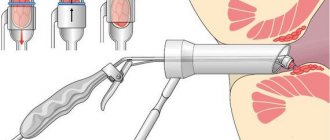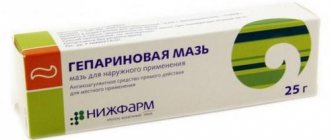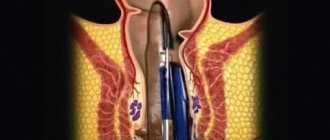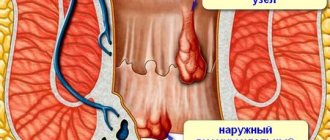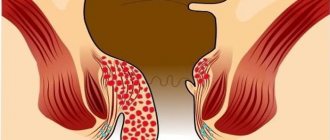Recently, proctologists have often begun to use ligation of hemorrhoids using latex rings to treat hemorrhoids. This minimally invasive method is considered an alternative to surgery for excision of varicose veins of the anus. It is performed on an outpatient basis and can significantly reduce the rehabilitation period for the patient. But is treatment always successful? Below we will discuss in detail the features of ligation and in what cases this method is used.
[contents]
Briefly about the main thing
Ligation of hemorrhoidal nodes with latex rings is a minimally invasive non-surgical method, the mechanism of action of which is to mechanically compress the node’s stem in order to stop the supply of blood to the pathological element.
The technique is used for bloodless removal of internal hemorrhoids and is characterized by a short list of contraindications, minimal risk of complications and a short recovery period.
Before the operation, you should cleanse the intestines, and during the short rehabilitation period, adhere to a diet, observe a protective regime and take medications prescribed by your doctor.
The only drawback of the low-traumatic technique is its limited use. Ligation is not recommended for irreducible hemorrhoids, large and multiple elements, as well as complicated pathology. Therefore, you should contact a proctologist as early as possible!
Cost of surgical treatment
Removing hemorrhoids using latex rings costs from 2000 rubles. The cost is affected by:
- type of technique (vacuum will cost a little more);
- features of the course of the disease;
- reputation of the clinic;
- region.
On average, in Moscow, the cost of ligating one uncomplicated node will be 5-6.5 thousand rubles, and the same operation in Kazan will cost 3.5-4.5 thousand rubles.
When contacting the clinic, do you need to clarify whether the examination is included in the cost of treatment? Consultations with specialists and diagnostic studies can increase the payment amount by another 1-2.5 thousand.
The essence of the technique
Ligation with latex rings is used for radical treatment of internal uncomplicated hemorrhoids I-II, in some cases - stage III.
The essence of the method is mechanical disconnection of the node from blood supply by ligating its stem. Stopping the blood supply leads to the death of the node.
The nodes come off together with the applied ligature. This is an invisible, completely painless process for the patient.
Ligation of hemorrhoids with latex rings is a fairly effective method. To prevent the disease from returning, it is necessary to adhere to the rules of prevention.
Possible complications
Treatment of hemorrhoids with latex rings is successful in most cases, but some patients develop complications. Most common:
- Heavy bleeding. It may appear immediately after the procedure or develop after rejection of a dried lump.
- Long lasting pain. Pain in the first days after ligation is considered normal, but if pain in the intestines persists for more than a week, then you need to consult a proctologist: perhaps the ligature was applied incorrectly.
- The appearance of signs of inflammation (fever, increased pain, discharge from the anus). The inflammatory process develops in patients with weakened immunity.
- Ligature slipping and coming out.
- Appearance of cracks. After the pulled knot is rejected, a wound remains in its place.
Medical statistics show that most complications after hemorrhoid ligation occur due to patients’ failure to comply with medical recommendations in the postoperative period.
Diagnostics
The main diagnostic procedure is endoscopic examination of the rectum (anoscopy). This method, absolutely harmless to the body, will provide a full amount of information: ___• the number of internal hemorrhoids, their size and location, ___• the condition of the intestinal mucosa, ___• the presence of complications and concomitant pathologies of the rectum
In cases where there is reason to suspect a pathological process in the overlying parts of the large intestine, colonoscopy is prescribed.
If the decision is made in favor of ligation, standard preoperative diagnostic tests (laboratory tests) are prescribed.
Indications for ligation of hemorrhoids
Treatment of hemorrhoids with latex rings, although popular in proctology, is not applicable to every type and stage of hemorrhoids. If we are talking about the initial stages of the disease, then it is quite possible to get by with drug treatment or even folk remedies. But as soon as the disease gets a little worse, such remedies turn out to be powerless, intervention is required.
At the first stage of hemorrhoids
The disease has not yet advanced, there is no severe pain. There may be bleeding, and even then occasionally, the nodes do not fall out. Medications are quite suitable for treatment, however, in cases where surgical removal of hemorrhoids is needed, proctologists often prescribe ligation. This method is also relevant when there is a threat of necrosis and inflammatory processes in the rectum. At the first stage, the procedure is completely painless, and recovery rarely takes more than 2 weeks.
In the second stage of hemorrhoids
At this stage of the disease, pain intensifies and bleeding becomes more frequent. Physical discomfort may occur, accompanied by a sensation of a foreign object in the rectum.
In this case, you must first deal with them through the use of medications or even surgery. The same thing happens if internal nodes begin to fall out.
In the third stage of hemorrhoids
Bleeding is frequent, pain does not subside for several hours, defecation is difficult, nodes often fall out, although sometimes they can still be set on their own. At the third stage of hemorrhoids, proctologists are less likely to prescribe ligation than at the second stage. This is primarily due to the constant loss of internal nodes and the formation of external ones. However, for modern medicine, little is impossible; latex rings for hemorrhoids are successfully used at this stage.
At the fourth stage of hemorrhoids
The most severe stage, causing severe pain and constant physical discomfort. If such hemorrhoids develop, ligation with latex rings may not be helpful. Proctologists prefer complex treatment with medications, sometimes prescribing surgical removal of nodes.
However, ligation is sometimes prescribed, but only in cases where the threat of inflammatory processes and thrombosis is minimal
In addition, the absence of external components is important
Contraindications
The ligation procedure will have to be postponed in case of acute inflammatory process, as well as in case of exacerbations of chronic diseases. Treatment is not carried out during the recovery period after serious illnesses, vascular accidents, injuries, or operations.
Ligation of the internal node is not indicated for combined (internal and external) hemorrhoids, as well as in cases where the underlying disease is accompanied by other pathologies of the rectum: ___• proctitis, ___• anal fissure, ___• polyps, ___• malignant intestinal tumors.
In addition, minimally invasive interventions are not prescribed for complicated forms of pathology (thrombosis, rectal fistulas, bleeding).
Interventions are carried out with caution in cases of blood clotting disorders, liver pathologies, diabetes mellitus, and severe pathologies of the cardiovascular system.
Carrying out ligation
Ligation with latex rings is carried out with special instruments (anoscope and ligator). The anoscope is inserted into the anus, the ligator is used to grab and pull the knot into the ring. Latex ligation of enlarged hemorrhoids is performed without anesthesia to determine the patient’s sensations and the force of tightening the ring.
Such measures are taken to eliminate postoperative pain; patients are given local anesthesia during the intervention if the sensations during the session are excessive.
Preparation
Preparation for the procedure begins 2-3 days in . It is necessary to stop taking medications that affect blood clotting (aspirin, ibuprofen) and switch to an intestinal-friendly diet.
The list of restrictions includes: ___• coarse vegetable fiber (cabbage, fresh vegetables and fruits), ___• legumes, ___• whole milk, ___• fatty foods, ___• sweets, ___• pickles, marinades, spices, ___• carbonated drinks, ___ • alcohol.
The day before your visit to the doctor, it is recommended to have an early light dinner and a light breakfast in the morning.
Colon cleansing is carried out twice: in the evening and in the morning using the Microlax microenema.
Technique
The procedure is performed with the patient lying on his side with his legs bent. The proctologist inserts an anoscope into the anus to, under visual control, apply an elastic hypoallergenic loop - a ligature - to the base of the node.
To carry out the operation, a special device is used - a vacuum ligator , with the help of which the pathological element is captured and a latex ring is put on it.
The manipulation is absolutely painless for the patient and therefore can be performed without anesthesia. The duration is less than an hour. At the end of the procedure, the patient can go home.
During one session, the doctor applies only one ligature. If there are several nodes, the procedure will have to be repeated. The interval between operations should be at least 1 week. Large formations are removed in stages. Your doctor will set a date for your follow-up visit.
Types of ligation
Ligation with latex rings is performed using an anoscope, which is inserted into the rectum. Another tool used is a ligator, which holds and tightens the lump into a ring.
This procedure is most often performed without anesthesia. This is due to minimal pain. In addition, during the procedure, the surgeon may ask the patient whether the ligature has been tightened too much. If the procedure causes excessive pain to the patient, local anesthesia may be used. Depending on the method of installation of the rings, the ligation procedure can be carried out in various ways.
Mechanical method
Mechanical ligation of nodes is carried out in a special chair. An anoscope is inserted into the anus, after which a ligator is inserted into it, with the help of which the lump is captured.
Once the nodule is retracted, the doctor activates the ligator to release the ligature onto the lump. The latex ring compresses the hemorrhoid without damaging healthy areas of the rectum or anus.
The mechanical method is recommended if the base of the hemorrhoids is clearly visible. This procedure takes no more than a quarter of an hour and requires only a surgeon and one assistant.
Vacuum method
In this procedure, a special ligator with a suction attached to it is brought to the nodule using an anoscope. After connecting the suction, the doctor closes the hole in the device to create pressure. This leads to tightening of the knot. The doctor places two ligatures at its base.
Once this procedure is completed, the surgeon opens a hole in the suction to stabilize the pressure. If this is not done, the nodule may rupture and bleeding may begin. The vacuum method is a more modern and simpler procedure. To perform it, it is not necessary to have an assistant present - the doctor can perform the procedure independently. In addition, this ligation method is effective even if the hemorrhoidal cones have unclear outlines.
Unpleasant consequences and methods of dealing with them
Unpleasant sensations
The most common side effect after applying a latex ring to an internal hemorrhoid is a sensation of a foreign body in the rectum. Medical measures are not indicated in such cases; over time, the intensity of the sensations decreases and does not cause concern to the patient.
pain may occur , the severity of which depends on a number of factors (the size of the node, its location, the characteristics of the patient’s individual sensitivity).
Pain should be relieved using medications recommended by your doctor. In case of resistant (constant) pain syndrome, you should consult a specialist, since pain can be a symptom of the development of complications.
Blood clot formation, bleeding, inflammation
___1. Blood clot formation is a very rare complication. The actions of doctors will depend on the situation: both conservative and surgical treatment may be prescribed. ___2. Sometimes such an unpleasant side effect occurs as staining of stool with blood . Most often, blood in the stool appears during the natural passage of a pathological element. Less commonly, the symptom indicates injury to the node with feces and/or the development of complications. If severe bleeding occurs, you should immediately consult a doctor. ___3. Inflammatory processes during minimally invasive interventions are extremely rare. As a rule, an infectious-inflammatory process occurs as a result of trauma to the nodule with solid feces, so to prevent complications it is necessary to adhere to a diet.
Latex ring slipping
Premature slippage of the latex ligature is a fairly rare complication that will invalidate the result of the operation. As a rule, the cause of slipping is excessive physical effort (weight lifting, sports, straining due to constipation). If this happens, contact your healthcare provider to have the procedure repeated.
Consequences of hemorrhoid ligation with latex rings
The hemorrhoidal node causes inconvenience to the patient as long as it receives nutrition from the circulatory system; ligation of hemorrhoids with latex rings can solve this problem. After the leg is tightened, the blood supply to the node stops, the dilated vessel dies and is subsequently rejected.
The hemorrhoidal node causes inconvenience to the patient as long as it receives nutrition from the circulatory system; ligation of hemorrhoids with latex rings can solve this problem.
Like any other therapeutic method, ligation has positive and negative sides. The advantages include:
- Speed in execution. The procedure lasts no more than 20 minutes.
- No need for hospitalization. If the patient does not engage in heavy physical labor, after leaving the clinic, he can return to his usual lifestyle.
- Rapid disappearance of hemorrhoid symptoms. After ligation, pain, bleeding, and burning in the anus disappear.
Ligation has the following disadvantages:
- High cost. The price of the procedure is determined by the status of the clinic and the need for related activities.
- Inability to eliminate the cause of hemorrhoids. Ligation does not help get rid of diseases of the digestive and immune systems, or vascular insufficiency.
- Possibility of recurrence of hemorrhoids. In this case, repeated intervention is prescribed.
- Increased risk of complications associated with tightening of the intestinal mucous membranes.
High cost is one of the disadvantages of ligation.
Ligation of hemorrhoids is indicated:
- with prolapse of hemorrhoids;
- if conservative therapy is ineffective;
- if it is impossible to reduce the cones;
- with the constant presence of unpleasant sensations;
- if dangerous complications of the disease occur.
Ligation is not performed in such pathological conditions as:
- blood clotting disorder;
- presence of anal fissures (relative contraindication);
- a combination of internal and external hemorrhoids with the absence of a pronounced border between dilated vessels;
- acute and chronic inflammatory processes in the rectal area;
- malignant tumors of the large intestine;
- the initial stage of the disease, in which the nodes are small.
If there is a bleeding disorder, ligation is not performed.
Before ligation is carried out, the following steps take place:
- Visit a proctologist and undergo an examination. During this period, the patient undergoes blood tests, an anoscopy, colonoscopy, and an ECG.
- Following a special diet. A week before surgery, foods that can disrupt the functions of the digestive system - fatty and fried foods, smoked foods, alcohol - are excluded from the diet.
- Discontinuation of certain medications. Avoid taking anticoagulants one week before ligation.
- Purgation. In the morning on the day of surgery, microenemas or laxative suppositories are used.
- Carrying out hygiene procedures.
During the operation, the bases of the hemorrhoids are compressed with latex rings. To do this, an anoscope is inserted into the rectum, the node is grabbed with a ligator and compressed with a ring. It tightly covers the leg, stopping the blood supply. A scar is subsequently formed at the site of the node.
When ligating a hemorrhoid, the proctologist must check whether the cones are pulled too tightly and whether pain occurs. If pain occurs, an anesthetic injection is given. Ligation is performed on an outpatient basis; 1-2 nodes are ligated at a time. The break between procedures is at least a month.
The mechanical method includes the following steps:
- insertion of an anoscope into the anus and its fixation;
- installation of a mechanical ligator in the lumen of the anoscope;
- seizure of the hemorrhoid;
- retraction of the cone into the head of the ligator and application of a latex ring.
Mechanical ligation is suitable for eliminating internal hemorrhoids, in which dilated vessels have clear boundaries and thin stalks. The entire operation lasts 10 minutes and is performed without anesthesia.
Through the anoscope, a vacuum ligator connected to a suction is brought to the lump. When the device is turned on, pressure is created, due to which the assembly is pulled into the head of the device. After this, the leg is clamped with a latex ring.
Vacuum ligation is the safest and most convenient procedure that does not require the participation of an assistant. It is used for the combined form of the disease.
Rehabilitation after hemorrhoid ligation includes:
- The patient stays under the supervision of a doctor. If no complications arise 1 hour after removing the cones, the patient goes home. The presence of a foreign body in the rectum may be felt for several days.
- Drug therapy. Antibiotics, painkillers and anti-inflammatory drugs are prescribed.
- Following a special diet. The patient who has undergone ligation should eat liquid and semi-liquid food. After a few days, foods containing fiber are introduced into the diet. The amount of fluid consumed is adjusted to 2.5 liters per day.
- Taking laxatives if you have difficulty defecating.
Ligation of hemorrhoids can lead to the development of complications such as increased pain.
Ligation of hemorrhoids can lead to the development of complications such as:
- Massive bleeding. It can develop both in the first hours after the procedure, and during rejection of dead tissue. It is necessary to consult a doctor immediately, since in most cases repeated surgery is required.
- Increased pain. If the discomfort does not disappear after a few days of taking analgesics, latex rings for hemorrhoids are removed. The ligation may have been performed incorrectly.
- Ring displacement. Occurs when the recovery period is not managed correctly or the device is installed incorrectly.
- Thrombosis of hemorrhoids. The complication occurs quite rarely, but is dangerous to the life and health of the patient. In this case, urgent hospitalization and surgical treatment are necessary.
- Rectal stenosis. Sometimes the wound lingers with the formation of rough scars that disrupt the structure of the mucous membranes.
The risk of complications becomes minimal if you follow all the recommendations of the proctologist.
source
If hemorrhoids are in the last stages, conservative treatment methods will not work. In such a situation, operations or minimally invasive methods help. Increasingly, proctologists have begun to use ligation of hemorrhoids with latex rings, which is an excellent substitute for surgery.
Before talking about the indications, you need to understand what ligation of hemorrhoids is.
In medicine, ligation is the process of applying a ligature (a special thread used to ligate blood vessels).
When treating this disease, latex rings are used, placed on the inflamed node with a special device, due to which blood no longer flows into it. It atrophies and falls off, and after a while (1-2 weeks) the body gets rid of it.
Sometimes ligation of hemorrhoids is also prescribed for grade 4, when the structure of the nodes is clearly formed.
This minimally invasive method eliminates pain and other common symptoms and permanently removes hemorrhoids. Among the advantages of the procedure are:
- the patient should not be in hospital;
- general anesthesia is not used for manipulations;
- ligation during pregnancy is not contraindicated;
- affordable cost of treatment;
- short rehabilitation period.
Despite the safety of the method, ligation is not recommended if there is:
- I degree of the disease (hemorrhoidal cones are still located inside and have not formed);
- mixed hemorrhoids (there is no clear difference between external and internal);
- cracks in the intestinal mucosa;
- complication of inflammatory processes (proctitis, paraproctitis, etc.);
- blood diseases and clotting problems.
Latex ligation is performed by a proctologist as follows:
- The specialist inserts a device (anoscope) into the anus, and then grabs the knot with a ligator.
- The lump is retracted and a latex ring is pulled over it so that it tightly covers the base of the knot. Due to this, the ring prevents blood from feeding the node.
- After a few days, the node comes out, and a scar forms in the place where it fell off.
Latex rings contain only hypoallergenic, strong and elastic material that does not cause harm to the body.
The duration of ligation of internal hemorrhoids in one visit to the doctor is 10-15 minutes, and the patient does not experience pain, with rare exceptions.
The specialist performing the procedure should ask the patient if the rings are too tight and if he is experiencing pain. If they are present, an injection with anesthesia is given into the nodes to reduce sensitivity.
On what day after ligation does the node disappear? Everything here is individual, depending on the stage of the disease and other factors. On average, it takes 3 days for the tightened knot to dry out and wrinkle, and then simply fall off (on the 5th or 6th day). Eventually, the hemorrhoidal node along with the ring will come out during bowel movements, and a scar will appear in place of the collapsed node.
The procedure is well tolerated; immediately after it, the person calmly returns to his usual lifestyle, and the next day he can go to work. The patient does not stay in the hospital for a long time, since the recovery period is short, complications after manipulation are very rare.
Today in medicine there are the following methods of applying latex rings:
- Mechanical method. Having inserted the anoscope into the anus, the doctor must fix the device so that the hemorrhoidal lump is within the visibility range of the device. Next, the proctologist inserts the ligator into the anoscope and must grab the knot with a clamp, pulling it into the ligator. A special trigger mechanism allows you to apply a latex ring, which is subsequently tightened at the base of the knot.
- Vacuum ligation is a fairly new method of applying rings. A pressure generating device is inserted into the anoscope. Vacuum ligation of hemorrhoids ensures their rapid absorption into the device. After this, a ring is placed on the node, which is fixed at the base of the process. During this process, the doctor needs to control the pressure, otherwise the node can be completely torn off, causing severe bleeding.
- Suture ligation. This method uses ultrasound to determine the location of the artery that is responsible for feeding the hemorrhoid. The vein is ligated and the node is no longer saturated with blood.
Treatment of hemorrhoids by ligation is not considered an expensive procedure, because it allows you to say goodbye to this disease forever. The cost may fluctuate and depends on the location (region) of the clinic where the manipulation will be performed, the experience of the specialist, the medications used, etc.
Prices for ligation in Moscow clinics:
- "Euromed" - from 5 thousand rubles;
- “Center of Coloproctology” - from 6 thousand rubles;
- "Atlantika" - from 6.6 thousand rubles.
Preparation for the procedure begins with passing all the necessary tests prescribed by the attending physician. You will also need an enema or laxative, because stool is undesirable for 24 hours after the procedure. Diarrhea after hemorrhoid ligation will also not have a positive effect on healing, so it is important to follow the diet prescribed by your doctor throughout the entire rehabilitation period.
It is forbidden to take blood thinners the day before to avoid severe bleeding.
With this method, the patient does not need to stay in the hospital for a long time, and rehabilitation is relatively quick.
For a speedy recovery and to avoid complications, the following recommendations must be followed during the postoperative period:
- On the first day, be sure to follow bed rest. Limit sports activities for a month; light physical activity, running and swimming are allowed. Heavy lifting and the use of hard toilet paper are prohibited.
- After surgery, you cannot sit for at least 3 days; the patient should only be in a lying or sitting position.
- Compliance with the diet and diet prescribed by the doctor will soften the stool and achieve a speedy recovery, because constipation or stool retention should not be allowed. The diet should include fermented milk products, fruits and vegetables.
- Use of medications. Analgesics if pain is present (2-3 days); laxative, for example, Duphalac (up to 1 month); anticoagulants (usually Warfarin, for 5 days); After the procedure, rectal suppositories with anti-inflammatory and healing effects are used for a month.
The attending physician will give you a complete list of recommendations; it is very important to adhere to them, then recovery will occur quickly and there will be no unpleasant consequences.
The painlessness and simplicity of the method does not guarantee the patient the absence of complications, among which are:
- Discomfortable sensations in the first days. This is a common consequence of surgery and does not last more than two days. The doctor should warn that defecation immediately after surgery or during the first day often leads to complications. To avoid this, it is important to carry out preoperative preparation with an enema.
- Pain. If pain persists for more than two days after manipulation, this may indicate incorrect application of the ring. Here you need to contact your doctor, who will check and correct the situation.
- Inflammation. This is a rare side effect, occurs in patients with poor health, they have the hardest time with the procedure
- Blood after ligation. It happens that the ring is rejected, this can cause bleeding immediately or even 7 days after the manipulation. This is often caused by non-compliance with the specialist’s recommendations in the period after surgery, for example, non-compliance with the diet, lifting something heavy, straining during bowel movements, etc.
- The latex ring will slip and may come out before the knot atrophies. This is also caused by non-compliance with the mandatory prohibitions given by the specialist (lifting weights, using solid toilet paper, refusing bed rest, etc.)
- Anal fissure at the site of the scar where the node fell off. This complication occurs with constipation, lack of proper hygiene care, and hard stool due to poor nutrition. In this case, you should contact a proctologist for conservative treatment.
- Infection. Temperature after ligation of hemorrhoids, weakness, problems with urination - all this may indicate infection.
The proctologist will recommend fasting for a whole day after the procedure, and then follow the rules of gentle nutrition for the whole month.
During rehabilitation, it is very important to drink a lot of high-quality clean water, but exclude tea, coffee, kvass and any carbonated drinks.
What can you eat after doping?
- bran bread;
- fruits (but apples, dates, raspberries and gooseberries should be excluded);
- soups;
- lean meat (for example, chicken breast), fish;
- fermented milk;
- vegetables (exclude white cabbage, spinach, radishes, sorrel, turnips).
You will have to exclude from the diet:
- smoked, spicy and highly salted foods (sausage, fish, etc.);
- sweet;
- Rye bread;
- legumes (beans, peas, corn, etc.);
- indigestible fatty meat products (lamb, pork, goose, mushrooms).
Meals should be small, 5-6 times a day.
If you follow all the doctor’s recommendations regarding diet and exercise, healing will take place very quickly and without complications.
There is no need to be alarmed if there is pain in the first couple of days after the procedure, you should go to the doctor and he will prescribe a pain reliever.
Almost 80% of patients give positive feedback about ligation, and this only confirms the effectiveness and safety of the procedure.
After a difficult birth, when visiting the toilet, I began to notice blood there, I went to a specialist, it turned out that it was hemorrhoids. I was immediately prescribed this procedure. Everything went quickly enough, I didn’t experience any unpleasant sensations. But after a couple of days it started to hurt a lot there. I ran to the doctor again, as it turned out, this was due to the fact that I was lifting weights. The doctor checked that everything was healing well, prescribed painkillers, and scolded me for not following his recommendations. It's good that there was no bleeding.
For a long time I suffered from constipation due to constant sitting at work and at home, but only when blood discharge appeared from the anus did I decide to consult a specialist. He prescribed ligation. Mom was scared and said a scary name, but I decided to do the procedure. As it turned out, it didn’t hurt at all and was quick enough – only ten minutes. Now I am not tormented by hemorrhoids and I hope that they will never return.
I suffered from this disease for 6 years, like most people, I just can’t stand doctors and hospitals, but still my wife forced me to. 4 ligation procedures were prescribed. So far I only survived the first time, it hurt for a couple of days, I took analgesics. Now everything is over, I'm looking forward to the second stage.
Ligation with latex rings is a safe, new, painless and affordable method of treating the disease. If you follow all the instructions of the proctologist, the removal of hemorrhoidal cones will take place without complications. Painkillers for hemorrhoids will relieve possible pain. Increasingly, patients began to choose this particular method because of its affordable price, lack of hospital treatment, speed of the procedure and, most importantly, getting rid of hemorrhoids forever.
source
In many coloproctology clinics in Russia, such a minimally invasive method of treating internal hemorrhoids as ligation of hemorrhoids with latex rings is becoming increasingly widespread. To perform it, a special mechanical or vacuum device is used, which allows you to cast a latex rubber ligature.
This treatment method has become popular among doctors and patients due to its simplicity and effectiveness. It can be used among a wide group of patients, including among those patients who are contraindicated for radical surgery or other minimally invasive methods of eliminating hemorrhoids.
The further effectiveness of treatment using the method of ligation of hemorrhoids largely depends on the correct determination of the indications for its implementation. To do this, the proctologist must prescribe a comprehensive set of diagnostics to the patient and clearly determine the stage of hemorrhoids.
Indications for performing ligation of hemorrhoids are the following clinical cases:
- II-III stage of hemorrhoids;
- Stage IV of the disease, accompanied by prolapse of nodes (in the absence of external hemorrhoids).
The procedure can be performed without the use of general anesthesia or spinal anesthesia, and this significantly expands its indications among groups of patients for whom these types of anesthesia are contraindicated. That is why the treatment of hemorrhoids during pregnancy, in the presence of contraindications to ligation with latex rings, can be carried out using this method.
Like any treatment method, ligation of hemorrhoids using latex rings may be contraindicated in some clinical cases of this disease:
- I stage of hemorrhoids;
- unclear boundaries in the combined form of hemorrhoids between external and internal nodes;
- anal fissures;
- acute or chronic paraproctitis.
Before ligation with latex rings, the patient must undergo a standard examination by a proctologist and such additional research methods as blood tests (biochemical, clinical) and Doppler ultrasound of the rectal vessels. After this, the doctor can determine the tactics for further preparation of the patient, taking into account the research results.
The standard procedure for preparing for ligation of hemorrhoids with rings without other concomitant diseases is simple, and the patient can perform it independently (if necessary, a cleansing enema will be performed in a medical institution).
It includes the following activities:
- Two days before the procedure, the patient is recommended to exclude from the diet foods that can cause constipation: rice, baked goods, pomegranate juice, etc.
- The day before the ligation, it is necessary to cleanse the intestines: for this, the day before you can use laxatives (Flyta or Fortrans) or perform a cleansing enema 5-6 hours before the procedure (you must make sure that all the water introduced into the intestines comes out) .
- The day before, the patient should shave the hair in the anus and perineum area.
- Dinner before the procedure should take place before 18:00. It is better that it consists only of broth and sweetened tea.
If necessary, the scheme of measures can be supplemented by the prescription of anticoagulants or temporary withdrawal of various medications that the patient takes constantly.
The procedure for ligating hemorrhoids with rings is carried out on a proctological or gynecological chair. Depending on the clinical case, the doctor may ask the patient to take a position “lying on the left side” with the legs pressed to the stomach or “lying on the back” with the legs thrown back on special supports. Next, the proctologist inserts an anoscope into the lumen of the rectum and fixes it so that the hemorrhoidal node is located in the lumen of the device.
After completing these preparatory manipulations, the procedure can be performed in two ways:
- mechanical ligator;
- vacuum ligator.
The procedure for a proctologist when using a mechanical ligator is as follows:
- The device is inserted into the anoscope.
- The knot is grabbed with a special clamp and pulled through the head of the ligator.
- The doctor presses the trigger, and a latex ligature is thrown onto the stem of the knot.
- After this, the place where the ligature is applied is checked: it should not involve nearby tissues that are located below the serrated edge.
Typically, this ligation technique is used for nodes that have clear boundaries and a well-defined stalk. The procedure takes about 7-10 minutes.
The procedure for a proctologist when using a vacuum ligator is as follows:
- A vacuum ligator device is connected to the hemorrhoidal node, which is connected to a special suction device.
- When the suction is turned on, the doctor closes the hole located in the head of the vacuum ligator with his finger and the unit is sucked into the head by vacuum.
- After some time, a latex ligature is thrown onto the knot.
- The doctor removes his finger from the hole on the head and, after equalizing the pressure in the device, removes the ligator from the anoscope.
Unlike the procedure performed with a mechanical ligator, a vacuum device will allow the procedure to be carried out in cases where the hemorrhoid is not clearly defined and has a vague stalk.
After casting the ligature and removing the ligator from the anoscope, the doctor carefully removes the anoscope. After completing the procedure, the patient can get dressed and, having received the doctor’s recommendations, go home.
During one ligation session, latex rings can be applied to one or two nodes. This is explained by the fact that when trying to apply a ligature to three or more nodes, the patient may experience severe pain and other complications. If there is a need for ligation of multiple nodes, then the patient may need to perform several more of the same manipulations.
After bleeding caused by the latex ring, the hemorrhoidal node dries out and is painlessly removed out along with the feces. In the first two to three days after ligation, the patient may experience minor pain, which is eliminated by taking conventional analgesics (Diclofenac, Nurofen, etc.), or a sensation of a foreign body in the rectum, which soon goes away on its own.
In most cases, complications after ligation of hemorrhoids develop rarely and occur as a result of an incorrectly performed procedure or the patient’s failure to comply with the rules of the postoperative period. These include:
- intense pain in the rectum - occurs when the ligature is applied incorrectly or when it is applied to more than two nodes;
- thrombosis of external nodes - provoked by the wrong choice of groups of patients for ligation, develops when the boundary between external and internal nodes is unclear;
- bleeding – occurs when the ligature ruptures due to the insufficient size of the latex ring, tightening the knot too tightly or the latex ring jumping off during straining during the first act of defecation immediately after the procedure due to improper preparation of the patient, heavy physical activity or lifting weights;
- infection of the rectum - provoked by infection during the procedure.
All of the above complications can be prevented if the patient follows all the doctor’s recommendations and carefully considers the choice of blade and proctologist for ligation of hemorrhoids.
The procedure for ligating nodes with latex rings has the following advantages:
- the ability to refuse radical surgery in cases where the patient complies with the doctor’s recommendations and the procedure was carried out correctly;
- no need for pain relief during the procedure using general anesthesia and spinal anesthesia;
- the ligation session can be performed on an outpatient basis;
- a patient whose profession does not involve heavy physical labor does not need to give up work for a long time;
- the possibility of using the technique in patients for whom radical interventions are contraindicated (for example, in the treatment of hemorrhoids during pregnancy);
- the procedure, when carried out correctly, does not cause complications;
- affordable price of treatment.
Provided that all indications for the procedure are observed and the patient follows all the doctor’s recommendations, the node ligation procedure has the following disadvantages:
- short-term sensation of a foreign body in the rectum and minor pain, which can be eliminated independently or with the help of non-narcotic analgesics;
- slight bleeding from the rectum during the first act of bowel movement.
Medical animation on the topic “Latex ligation of hemorrhoids”:
source
Recovery period
Protective regime and hygiene procedures
All ongoing rehabilitation measures are aimed at speedy healing of the wound and prevention of complications: ___• In the first days, it is necessary to limit physical activity. You cannot lift weights exceeding 5 kg or visit the sauna. ___• A week after surgery, moderate physical activity is allowed: swimming and race walking. ___• The ban on strength sports and heavy physical labor remains in effect for a month. ___• Perineal toileting is carried out as usual (twice a day, morning and evening).
Diet food
The vast majority of complications after ligation surgery occur as a result of injury from solid feces. Therefore, it is necessary to exclude from the menu products that have an irritating and strengthening effect: ___• semolina porridge, rice, ___• potatoes, ___• legumes, ___• spicy and smoked dishes, ___• baked goods made from wheat, ___• carbonated drinks, ___• alcohol.
It is necessary to observe the temperature regime: you should not eat too hot or too cold foods. The optimal solution is warm, soft food: stewed, boiled, pureed (fried and smoked foods are strictly prohibited).
In order for the rehabilitation process to proceed at a normal pace, adequate nutrition is necessary: dietary meat, poultry, fish, boiled or stewed vegetables, and fermented milk products.
Medication support
To prevent complications of hemorrhoid ligation, proctologists prescribe drugs from several groups.
Painkillers from the group of non-steroidal anti-inflammatory drugs reduce the severity of pain and inhibit the inflammatory response. Such drugs are prescribed orally (Nurofen, Ketanov).
To avoid injury from hard feces, take stool softening laxatives (for example, Forlax).
Advantages and disadvantages of the procedure
In 85% of cases, patient reviews were positive and approved of the treatment method. The method excludes radical surgery. Relapse is practically excluded. The manipulation is simple and performed quickly - in 15-20 minutes, does not cause pain. In rare cases, anesthesia is used.
After the intervention, it is permissible to go to work the next day. The procedure does not require a long-term hospital stay, complications are rare.
Disadvantages: discomfort, pain, foreign body sensation, hemorrhage during bowel movements. To avoid this, you will need to follow the instructions of the proctologist and change your lifestyle.
How to protect yourself from relapse
Ligation of hemorrhoids is a reliable treatment method. However, if the patient is predisposed to developing this disease, hemorrhoids may recur.
To prevent a relapse, you should minimize the number of factors contributing to the development of pathology: ___• normalize stool, ___• get rid of excess weight, ___• give up spicy food and alcohol, ___• avoid prolonged sitting, ___• limit severe physical activity exercise, visiting a bathhouse, sauna, ___• it is recommended to engage in physical therapy, ___• promptly treat diseases of the gastrointestinal tract and genitourinary system.
Statistical data show that if all recommendations are followed, the relapse-free period after ligation of nodes can last indefinitely (10-15 years or more).
Recovery
Rehabilitation after hemorrhoid ligation includes:
- The patient stays under the supervision of a doctor. If no complications arise 1 hour after removing the cones, the patient goes home. The presence of a foreign body in the rectum may be felt for several days.
- Drug therapy. Antibiotics, painkillers and anti-inflammatory drugs are prescribed.
- Following a special diet. The patient who has undergone ligation should eat liquid and semi-liquid food. After a few days, foods containing fiber are introduced into the diet. The amount of fluid consumed is adjusted to 2.5 liters per day.
- Taking laxatives if you have difficulty defecating.
Is it possible to postpone the operation?
Ligation of hemorrhoids is a planned procedure that can always be postponed. Even gentle interventions must be carried out against the backdrop of physical and psychological well-being.
However, it should be taken into account that chronic hemorrhoids are prone to the development of complications such as: ___• thrombosis and bleeding of the node, ___• infectious and inflammatory complications (proctitis, paraproctitis), ___• anal fissure.
At the stage of irreducible hemorrhoids, with large and/or multiple nodes, as well as in the event of complications, doctors will be forced to abandon low-traumatic treatment methods in favor of traditional surgery (hemorrhoidectomy).
A long course of chronic hemorrhoids, accompanied by bleeding, leads to anemia, physical and nervous exhaustion.
Ligation procedure: advantages, indications, contraindications
Typically, the ligation procedure is performed at the second or third stage, less often at the fourth stage of the disease. At the initial stage, there is no need for ligation of hemorrhoids; drug therapy (ointments, gels, suppositories, tablets, etc.), physical therapy and diet are sufficient.
Ligation with latex rings is a successful alternative to surgery. Removal of hemorrhoids is carried out on an outpatient basis, is painless (performed under local anesthesia or without it at all), takes 10-15 minutes, and requires virtually no rehabilitation. The patient can immediately return to normal life.
Latex rings are usually applied to 1-2 nodes, so in the later stages of hemorrhoids, with many hemorrhoids, the procedure is carried out in several stages, with a break between them of 2-3 weeks. This approach minimizes the risk of complications.
To avoid the development of bleeding, before starting the manipulation, drugs that affect blood clotting should be discontinued (after consultation with your doctor).
Latex ligation is contraindicated in the following cases:
- lack of a clear boundary between external and internal nodes in the combined form of the disease;
- proctitis, paraproctitis;
- anal fissures.
Ligation with latex rings is not performed immediately after a myocardial infarction or stroke, in the presence of anemia, thrombocytopenia, acute infectious diseases, etc.
Relapses of the disease after treatment of hemorrhoids using latex ligation practically do not occur.
The patient is instructed that if the pain intensifies and becomes unbearable, it is necessary to seek immediate medical attention.


